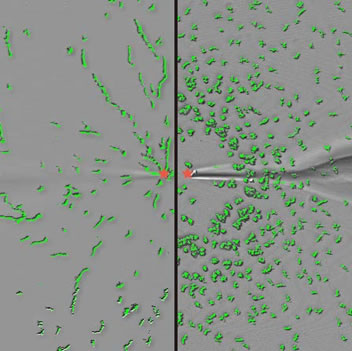Dictyostelium cells normally migrate (right) toward a high concentration of cAMP signal (red dot), but Dictyostelium cells lacking the Gip1 protein (left) lose their capacity to respond to such cues.
How chemotactic cells extend response range
Professor Ueda’s research group at Osaka University and Riken QBiC discovered a new protein factor that regulates the response range of eukaryotic chemotaxis and named the factor Gip1 (trimeric G protein interacting protein 1). Gip1 extends chemotactic range by regulating the intracellular distribution of G proteins that is a new regulatory mechanism for G proteins signaling.
Chemotaxis is directed cell migration and provides a unique spatio-temporally regulated signal transduction system to control early embryogenesis, neuronal wiring, wound healing, immune responses, and so on. Chemotactic cells share basic properties including high sensitivity to shallow gradients and responsiveness to a wide dynamic range of chemoattractants. The group identified a novel regulator of trimeric G protein as Gip1, which extends response range in chemotaxis. Their findings show three steps of Gip1 mediated response range extension. First, Gip1 sequesters the cytosolic pools of G proteins through binding, where cytosolic G proteins are not available for chemotactic signaling on the membrane. Second, upon stimulation with chemoattractant, G proteins dissociate from Gip1 and move to the cell membrane. Third, Gip1-dependent translocation supplies a signal transducer for chemoattractant receptors at higher ranges and causes a biased redistribution of G proteins on the membrane along chemical gradients. This biased redistribution contributes to proper gradient sensing at higher concentration ranges. These findings advance our knowledge of the molecular basis for wide-range sensing and is distinct from the chemical modification-based mechanisms of sensory receptors. This mechanism could be harnessed for broad dynamic range regulation that is a frequently observed feature of sensory cells.

(Link) http://resou.osaka-u.ac.jp/en/research/2016/20160407_2









